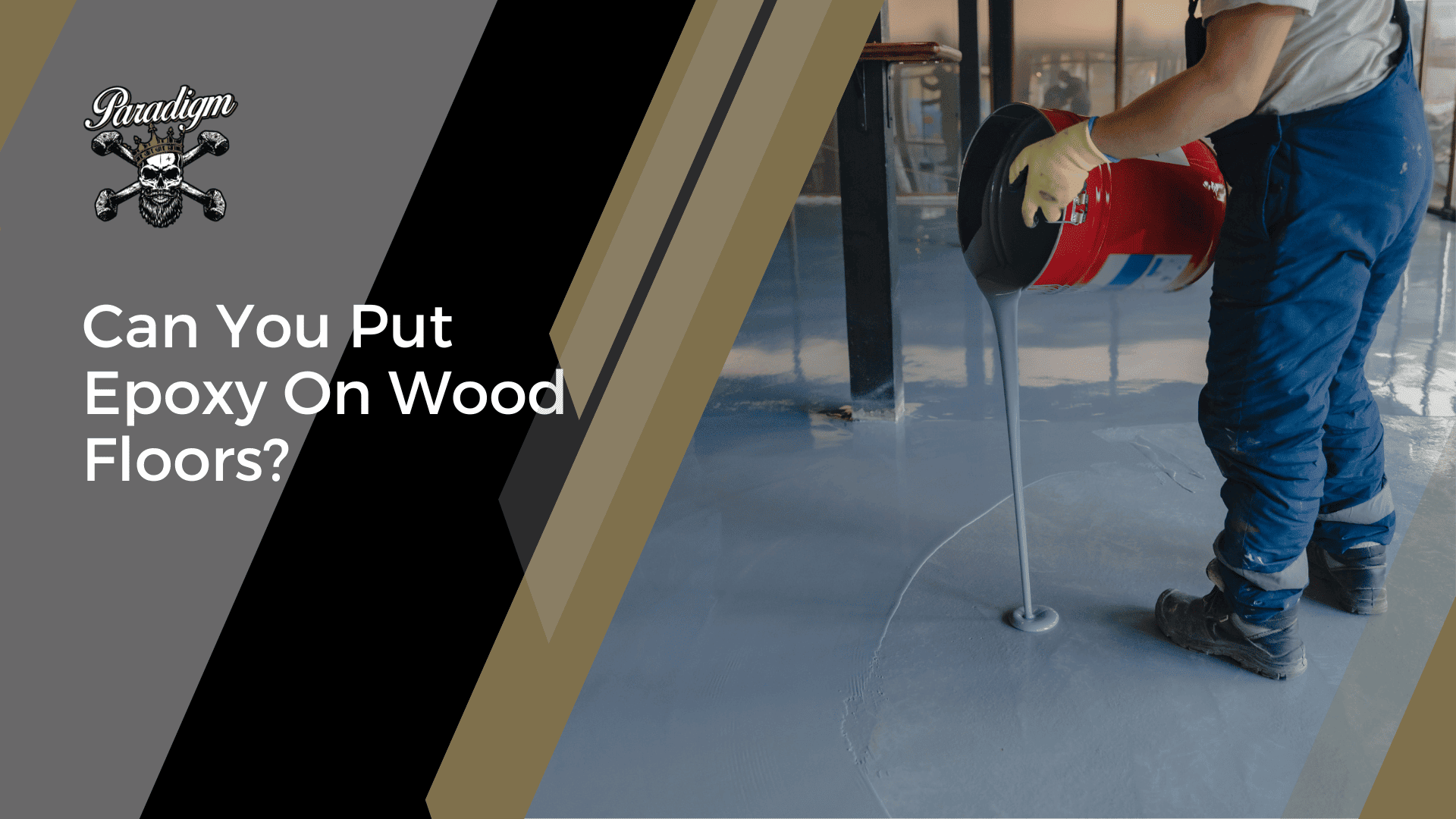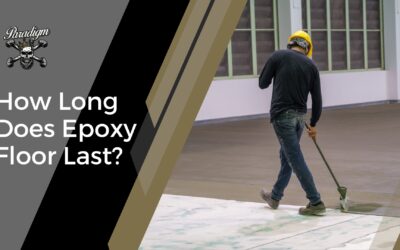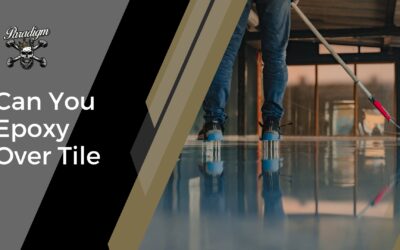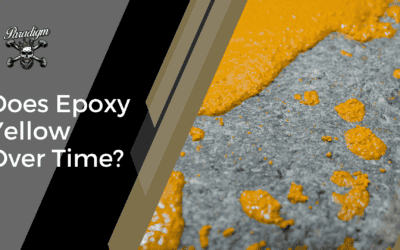If you’re considering giving your wood floors a new, durable finish, epoxy might be a solution that has caught your attention. Epoxy has become increasingly popular as a versatile and long-lasting coating for various surfaces, including countertops, tabletops, and even garage floors.
However, can you put epoxy on wood floors? Of course. Applying a clear epoxy coating is an excellent method to safeguard hardwood floors or transform older wood floors into more functional surfaces. Nonetheless, it’s important to note that proper preparation and application are crucial for the successful installation of epoxy on wood floors.
Table of Contents
Can you put epoxy on wood floors?
Yes, you can put epoxy on wood floors. However, there are some important considerations to keep in mind before applying epoxy on wood floors.
Wood is a natural material that can expand and contract with changes in temperature and humidity. Epoxy, on the other hand, is a rigid material when cured. This difference in properties can potentially lead to issues if not tackled properly. To ensure a successful application, it is important to properly prepare the wood surface by sanding it to create a smooth and even texture. This helps the epoxy adhere well to the wood.
Also, cleaning the wood thoroughly is important to remove any dust, dirt, or oils that could interfere with the epoxy’s adhesion. Applying a primer specifically formulated for epoxy on wood floors can also enhance the bonding and durability of the coating. The primer helps seal the wood and prevents moisture from causing issues such as warping or delamination.
One of the significant advantages of using epoxy on wood floors is its exceptional durability; epoxy coatings create a protective barrier that can withstand heavy foot traffic, scratches, and stains. This makes it an excellent choice for high-traffic areas. Epoxy can also provide a glossy and seamless finish that enhances the natural beauty of the wood, creating a visually appealing and modern aesthetic.
Factors to Consider When Applying Epoxy on Wood Floors
Some factors to consider when applying epoxy on wood floors include the type of wood, the condition of the wood, the moisture content, etc. Let’s get into each of the factors in more detail.
1. Wood Type
Different types of wood have varying characteristics, such as hardness, porosity, and natural oils. These factors can affect how well the epoxy adheres to the wood and how it interacts with the surface.
Some woods, like oak or maple, are commonly used for flooring and are generally suitable for epoxy coatings. However, certain exotic or oily woods may require special surface preparation or alternative coating options.
2. Condition of the Wood
The condition of the wood is a critical factor to consider before applying epoxy. It’s essential to ensure that the wood is structurally sound and free from any defects, such as cracks, splinters, or rot.
If the wood is damaged or unstable, it should be repaired or replaced before applying epoxy. Any existing coatings, finishes, or contaminants on the wood surface should also be removed through sanding or stripping to provide a clean and receptive substrate for the epoxy.
3. Moisture Content
Wood is naturally prone to absorbing and releasing moisture, which can cause expansion or contraction. Excessive moisture in the wood can negatively impact the adhesion and performance of the epoxy coating.
Therefore, it is crucial to measure and monitor the moisture content of the wood before applying epoxy. Moisture meters can be used to assess moisture levels, and it is generally recommended to ensure that the wood has a moisture content within the acceptable range specified by the epoxy manufacturer.
4. Surface Preparation
Proper surface preparation is key to achieving a successful epoxy application on wood floors. The wood surface should be thoroughly cleaned to remove any dirt, dust, or oils that could interfere with the adhesion of the epoxy.
Sanding the wood is typically necessary to create a smooth and even surface and promote better adhesion. It is important to follow the recommended sanding techniques and grits to prepare the wood properly.
5. Testing and Compatibility
Before proceeding with the full epoxy application, it is advisable to conduct a small test patch on a discreet area of the wood floor. This allows you to evaluate the compatibility of the epoxy with the wood and observe how the coating interacts with the surface. It also provides an opportunity to assess the desired appearance and make any necessary adjustments before applying epoxy to the entire floor.
How to Apply Epoxy on Wood Floors
Applying epoxy on wood floors requires careful preparation and precise execution to achieve a smooth and durable finish. Here is a step-by-step guide on how to properly apply epoxy on wood floors:
1. Surface Preparation
- Thoroughly clean the wood floor to remove any dirt, dust, or oils. Use a broom, vacuum, or damp cloth to ensure a clean surface.
- If there are existing coatings or finishes on the wood, such as varnish or wax, they should be removed through sanding or stripping. This step is crucial to allow the epoxy to bond properly with the wood.
2. Sanding
- Use a drum sander, orbital sander, or sanding block to sand the wood floor. Start with a coarse-grit sandpaper (around 60-80 grit) to remove any imperfections, scratches, or unevenness.
- Gradually progress to finer-grit sandpaper (around 120-150 grit) to create a smooth and even surface. Sand along the grain of the wood to avoid creating visible scratches.
3. Vacuuming and Cleaning
- Thoroughly vacuum the sanded wood floor to remove any dust or debris. Use a tack cloth or a damp cloth to wipe the surface and ensure it is completely clean.
4. Priming (optional)
- Applying a primer specifically formulated for epoxy on wood floors can enhance the adhesion and durability of the epoxy coating. Follow the manufacturer’s instructions to apply the primer evenly. Allow it to dry according to the recommended drying time.
5. Mixing the Epoxy
- Carefully read and follow the instructions provided by the epoxy manufacturer for mixing ratios and procedures.
- Pour the epoxy resin and hardener into separate containers, then combine them in the correct ratios. Use a stir stick or paddle mixer to thoroughly mix the components. Ensure that the mixture is well blended and free from any streaks or unmixed portions.
6. Application
- Start by cutting in the edges of the wood floor using a brush or foam roller. Apply a thin and even coat of epoxy along the perimeter of the room, working your way inward.
- Use a paint roller with a medium-nap or foam roller to apply the epoxy to the main surface of the wood floor. Work in small sections, rolling the epoxy evenly and smoothly. Avoid applying excessive pressure or overworking the epoxy, as this can create bubbles or unevenness.
- If multiple coats are required, allow the first coat to dry according to the manufacturer’s instructions before proceeding with additional coats. Sand lightly between coats to promote adhesion.
7. Curing and Drying
- After applying the final coat, allow the epoxy to cure and dry according to the manufacturer’s instructions. This typically involves a waiting period of several days or more.
- Avoid walking on or placing furniture on the epoxy-coated floor until it is fully cured and hardened.
Is Epoxy Good for Wood Floors?
Yes, epoxy can be a good option for wood floors. However, its suitability depends on several factors long-term performance, maintenance requirements, compatibility with wood species, and proper consideration of wood movement and UV sensitivity. Proper surface preparation, following manufacturer guidelines, and consulting with professionals can help ensure a successful and long-lasting epoxy application on wood floors.
What Kind of Epoxy Should I Use on Wood Floors?
For wood floors, it is generally recommended to use a high-quality, water-based epoxy coating specifically formulated for wood surfaces. Water-based epoxy coatings are popular for wood floors due to their low odor, ease of application, and environmental friendliness. They offer good adhesion to wood surfaces, provide durability, and are generally more user-friendly.
How Long Does It Take Epoxy to Dry on Wood Floors?
In general, epoxy coatings on wood floors can take anywhere from 24 to 72 hours to dry completely. It’s important to consult the manufacturer’s instructions or product label for the recommended drying time of the specific epoxy product you are using, as it may vary. Some factors that may influence the drying time for epoxy on wood floors include environmental conditions, specific epoxy products used, and the thickness of the epoxy application.
Final Thoughts
Epoxy can be applied to wood floors to enhance durability, protect against stains and scratches, and improve aesthetics. When considering epoxy for wood floors, it is important to properly prepare the wood surface by sanding and cleaning it. Opt for a high-quality, water-based epoxy coating specifically formulated for wood surfaces.
You should also factor in long-term performance, maintenance requirements, compatibility with wood species, wood movement, and UV sensitivity. To ensure that you get the best out of your epoxy installation, then contact Paradigm Concrete Finishes. We are a reputable epoxy installer in Florida that can provide expert guidance. Contact us today to get started.




